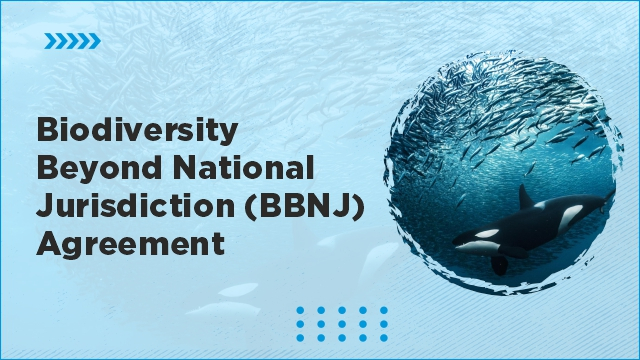1.What is the BBNJ Treaty? What will be its implications in conserving high seas? Critically analyse.
Approach: Introduction about BBNJ – Its objectives and facts- challenges- way forward.
The BBNJ treaty commonly referred to as the Treaty of the High Seas was agreed upon in March 2023 for the conservation and sustainable use of marine biological diversity in areas beyond national jurisdiction. It represents a crucial step towards conserving and sustainably managing marine biological diversity in areas beyond national jurisdiction.
Objectives of the Treaty:
●The treaty seeks to increase the percentage of protected areas on the high seas, which currently stands at a mere 1.44%, despite covering more than two-thirds of the global ocean.
●Additionally, it aims to ensure fair and equitable sharing of profits from marine genetic resources (MGR) and establish rules for conducting Environmental Impact Assessments (EIA), which deal with identifying and evaluating the potential impacts an activity could have on the ocean.
●This aligns with the 30×30 target, it is a global commitment to protect at least 30% of the planet for nature by 2030. It was agreed upon at the Convention on Biological Diversity (CBD) at the Conference of Parties (COP15) to the UN Convention on Biological Diversity in 2022 and is included in the Kunming-Montreal Global Biodiversity Framework.
Challenges in this treaty:
1.Insufficient Ratification:
○With only 14 of the 104 signatories ratifying the treaty, it remains far from the 60 required for enforcement.
2.Territorial Disputes and Hesitations:
○Overlapping maritime claims, especially in regions like the South China Sea, complicate consensus on MPAs.
○Coastal states fear MPAs could restrict economic opportunities and livelihoods dependent on marine resources.
3.Conflicts with Existing Regimes:
○Potential overlaps with frameworks like the Convention on Biological Diversity risk fragmenting governance.
4.Accountability Concerns:
○Wealthier nations may underreport activities related to marine genetic resource exploitation, undermining equitable benefit-sharing.
5.Asymmetry in Capacity Building:
○Lack of enforceable mechanisms for technology transfer perpetuates inequalities, sidelining less-capable nations.
6.Overlooking Interconnected Marine Ecosystems:
○Neglecting the impact of harmful activities in Exclusive Economic Zones (EEZs) on high-seas ecosystems.
7.Gaps in Environmental Oversight:
○Absence of provisions for harmful activities like oil and gas exploration within coastal waters.
Way forward:
●For the High Seas Treaty to succeed, it must overcome its structural and political limitations. This requires a radical shift in maritime governance — one that integrates high-seas and coastal regulations into a cohesive framework.
●Coastal states, particularly those in the Global South, need incentives to align their domestic laws with international norms, while wealthier nations must commit to providing technical and financial support to ensure the treaty’s benefits are equitably shared.
●The treaty’s success ultimately hinges on fostering a collective commitment among nations to safeguard the oceans as a shared global resource.
Source:
https://www.thehindu.com/opinion/op-ed/between-hope-and-hurdles-on-the-high-seas/article68913976.ece

